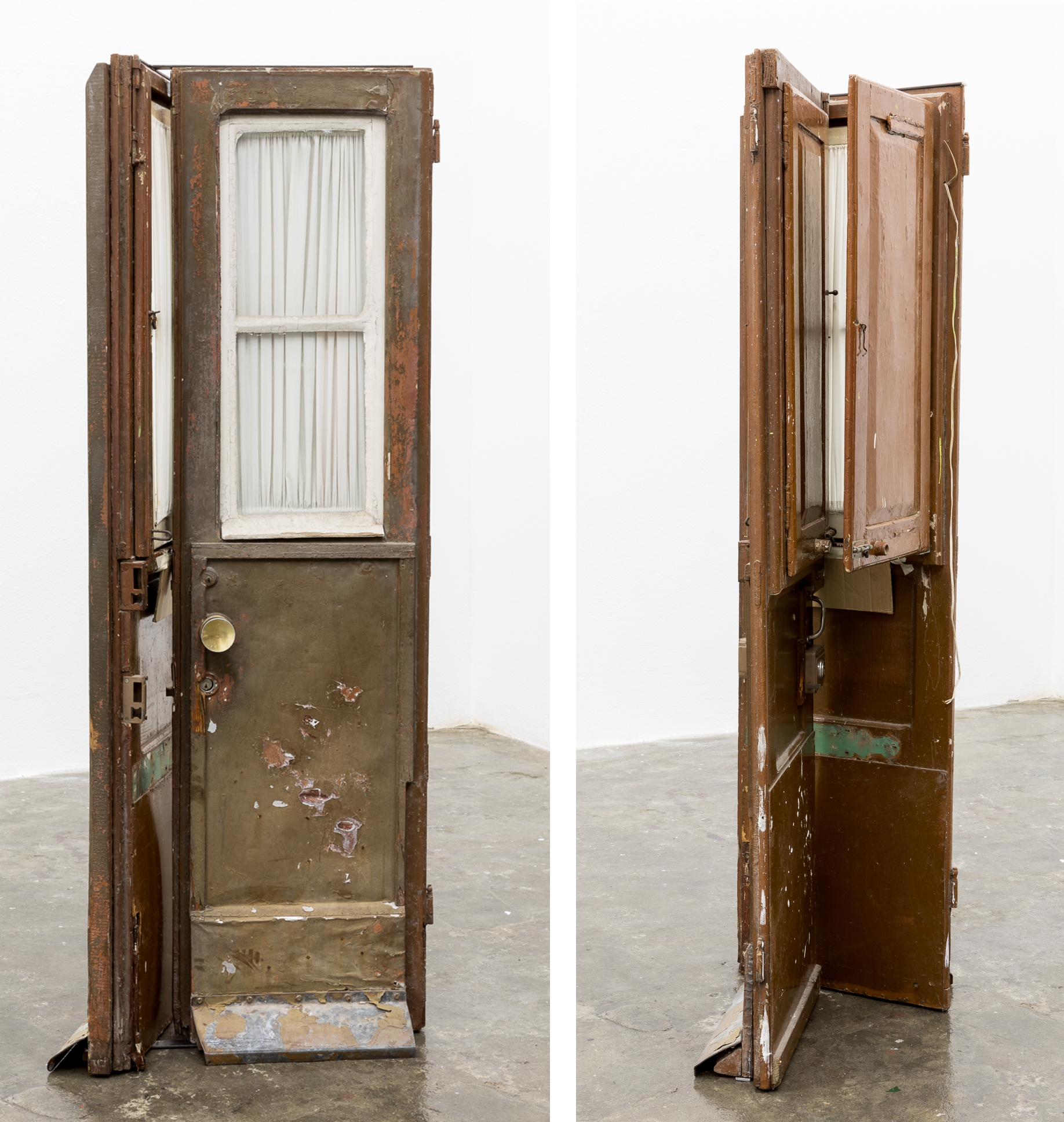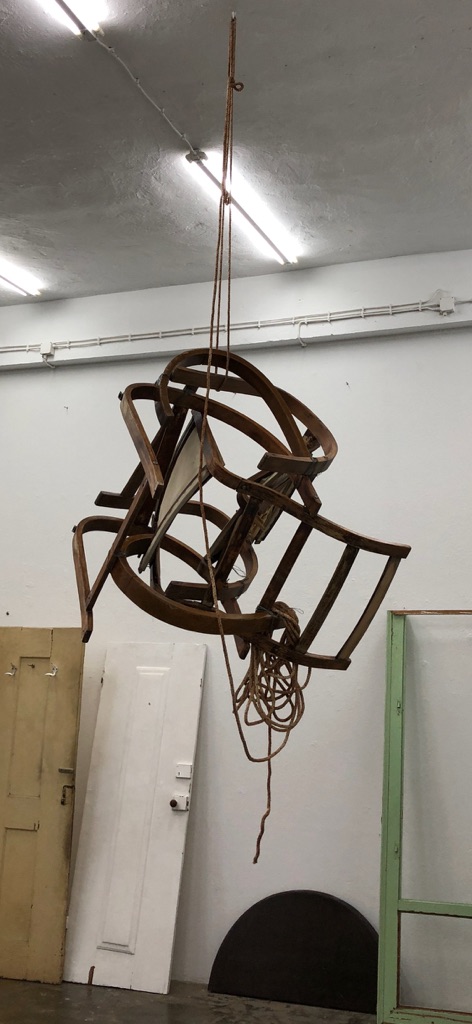Pedro Cabrita Reis was born in Lisbon in 1956, where he lives and works. Internationally recognized, his work became crucial to the understanding of sculpture since mid-1980s. His complex work, characterized by a philosophic and poetic idiosyncratic discourse, includes a great variety of media: paintings, sculpture, photography, drawings and installations made up from both found and manufactured objects. Using simple materials and submitting them to constructive processes, Pedro Cabrita Reis recycles almost anonymous reminiscences of everyday primordial gestures and actions. Centered in issues related to space and memory, his pieces acquire a suggestive power of association that, transposing the visual, achieve a metaphorical dimension.
The complex theoretical and formal diversity of the Cabrita Reis’ work proceeds from an anthropological reflection opposite to the reductionism from sociological discourse. In fact, his work rests in silences and inquiries.
His work has been exhibited in multiple museums and art centers, such as: “Sometimes one can see the clouds passing by”, Kunsthalle Bern, 2004; “Stillness”, Camden Arts Centre, London, 2004; “True Gardens #3 (Dijon)”, FRAC Bourgogne, Dijon, 2004; “Pedro Cabrita Reis”, MACRO, Museo d’Arte Contemporanea, Roma, 2006; “La ciudad de adentro”, OPA, Guadalajara, 2007; “True Gardens #6”, Kunsthaus Graz, Graz, 2008; “Pedro Cabrita Reis”, Fondazione Merz, Torino, 2008; “La Línea del Volcán”, Museo Tamayo, Mexico City, 2009; “Deposição”, Pinacoteca de São Paulo, 2010, “One after another, a few silent steps”, Hamburger Kunsthalle, Hamburg, 2009 – Carré D’Art, Nîmes, 2010 – Museum for Contemporary Art, Leuven, 2011 – Museu Colecção Berardo, Lisbon, 2011; “States of Flux – Pedro Cabrita Reis”, Tate Modern, London, 2011-2013; “A Remote Whisper”, 55a Biennale de Venezia, 2013; “Lifted Gaze”, De Vleeshal, Middelburg, 2014; “Alguns nomes”, Galeria Mul.ti.plo, Rio de Janeiro, 2014; “Fourteen paintings, the preacher and a broken line”, The Power Plant, Toronto, 2014; “The London angles”, Sprovieri Gallery, London, 2014; “The Field”, Peter Freeman Inc., New York, 2014; “Herbarium (Madrid)”, Galeria Juana de Aizpuru, Madrid, 2015; “Les lieux fragmentés”, Hotel des Arts, Toulon, 2015; “A few drawings, a façade inside and a possible staircase”, The Arts Club, Chicago 2015; “Pedro Cabrita Reis”, Kewenig Galerie, Berlin 2015; “Pedro Cabrita Reis”, Konkrete Mehr Raum!, Osnabrück 2015; “La casa di Roma – L’Albero della Cuccagna”, MAXXI – Museo Nazionale delle Arti del XXI secolo, Rome 2015; “A casa de Coimbra – anozero’15 – um lance de dados, Bienal de Arte Contemporânea de Coimbra”, City Room, Santa Cruz Convent, Coimbra 2015; “Todo o Património é Poesia”, Eugénio de Almeida Forum, Évora 2016; “Fallen and Standing”, Kewenig Galerie, Palma de Mallorca 2016; “Show me your wound – TEFAF Maastricht”, Maastricht Exhibition and Congress Centre (MECC) 2016; “Art Unlimited / Basel 2016”, Halls Messe Basel, Hall 2.1, Basel 2016; “DA COLEÇÃO EM LISBOA – O Olhar do Artista: Obras da Coleção de Serralves”, Torreão Nascente da Cordoaria Nacional, Lisbon 2017; “Das pequenas coisas”, Atelier-Museu Júlio Pomar, Lisbon 2017; “Parcours”, Art Basel, Basel’s Münsterplatz, Basel 2017; “Col-Lecció per Amor a L’Art. Ornament = Delicte?” Bombas Gens Centre d’Art, Valencia 2017.
In 2001, the VIth International Sculpture Symposium of Santo Tirso incorporated an emblematic piece by Cabrita Reis. Rising as a house, which has always been present throughout his vast production, that piece may lead us to a deeper understanding of this recurrent topic and of the artist’s thoughts and practice.
In majority of the pieces that Cabrita Reis brings to this exhibition, almost all of them new, it can be seen an intricate set of ideas and shapes that offers a discovery, or even a reading, through the permanent combination and intermingling of materials and objects immediately recognizable by viewers. Such objects, after they are considered useless and discarded by their owners, are obsessively and carefully collected by the artist, who once in his atelier brings them together at will, giving them a new life now loaded with historical, philosophical, political and poetic meaning.
Of monumental size, the piece designed for the long corridor of the Abade Pedrosa Municipal Museum elicits a particular reading / discovery / experience of the Lisbon atelier where Cabrita Reis has worked since 2006.
The exhibition will be open since July 3rd and in the end it will be produced a catalogue with texts from Álvaro Moreira and Miguel von Haffe Peréz.
Opening: 03.07.2018 at 19h30
———————
EDUCATIONAL & RECREATIONAL ACTIVITIES
Guided tour through the sculpture park / Art-Archaeology-Architecture guided tour
Sculpture Workshop for schools – Educational Services
“Unexpected Art”
Preschool to High School and Senios | 25/30 participants | July 3 to September 22, 2018
Archaeology Workshop for schools – Educational Services
“Warrior”
Preschool to Middle School | 25/30 participants | July 3 to September 22, 2018
Archaeology Workshop for schools – Interpretative Centre of Monte Padrão
“Skeleton”
Preschool to Middle School | 25/30 participants | July 3 to September 22, 2018
Archaeology Workshop for schools – Interpretative Centre of Monte Padrão
“Digging”
Preschool to Middle School | 25/30 participants | July 1 to August 31, 2018
Family workshop
“Piece by Piece” – Educational Services
Families | 15 to 20 participants | September 8, 2018






